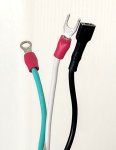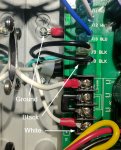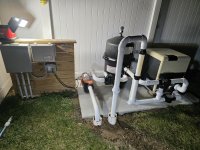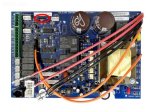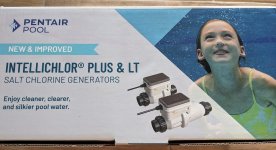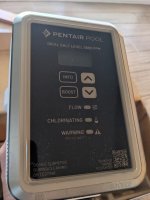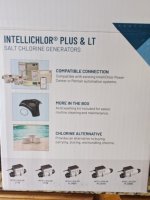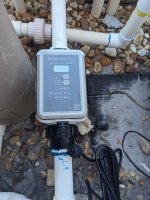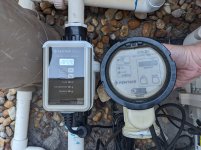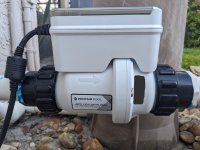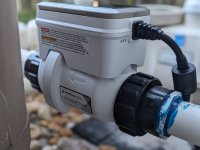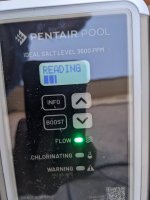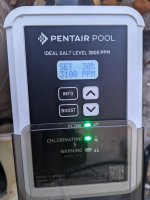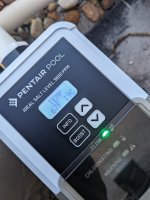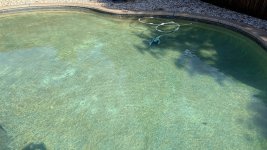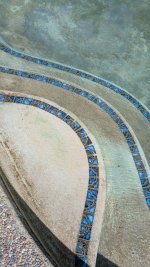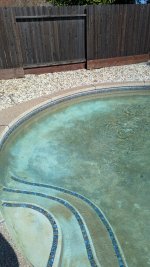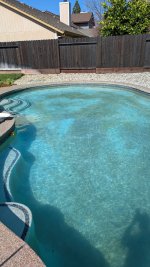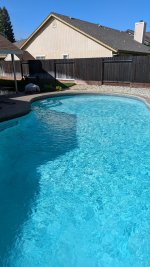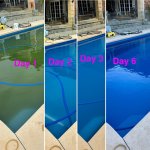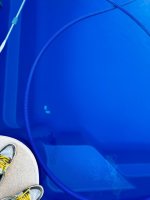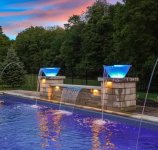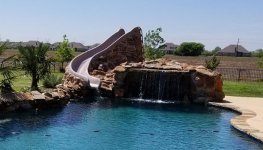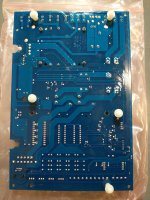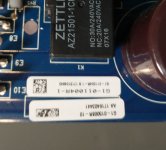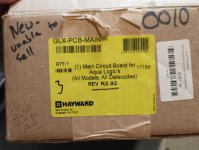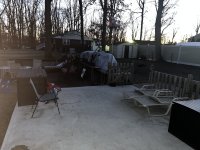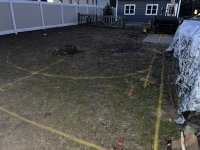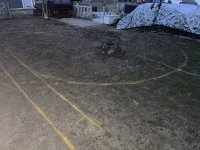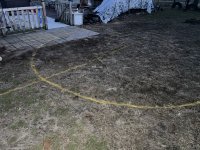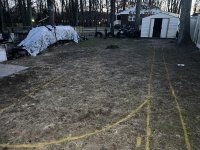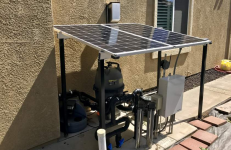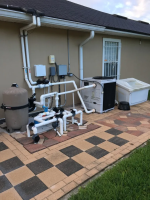I originally posted the following on another forum (I thought I also posted it here, but can't find it).
First, I describe exactly what is in chlorinating liquid and bleach as far as we know. I'll use 12.5% chlorinating liquid as an example.
This link is a typical example. Though they do not list the amount of salt (since it doesn't affect the lifetime of the chlorine), this is known to be equivalent to the amount of chlorine due to the way it is manufactured (by adding chlorine gas to a solution of lye). The "12.5%" chlorinating liquid is a "trade %" which is not the same as a weight percentage and is why that's a different number below. Also, the salt and chlorine are in the same quantity in terms of numbers of molecules, but these molecules differ in weight which is why the percentages of chlorine and salt differ below.
Code:
Chlorine (sodium hypochlorite) 11.3% (10.8% weight % of available chlorine; 12.5% volume % of available chlorine aka Trade %)
Lye (sodium hydroxide) 0.3%
Salt (sodium chloride) 8.9%
Water 79.5%
Now let's look at the ingredients in Lithium Hypochlorite where I'll use
this link for Burn Out 35 as an example.
Code:
Chlorine (lithium hypochlorite) 29% (35.2% weight % available chlorine)
Sodium Sulfate 13%
Postassium Sulfate 6%
Lithium Chloride 4%
Lithium Carbonate 2%
Lithium Chlorate 2%
Lithium Hydroxide 1%
Salt (sodium chloride) 36%
Water 7%
It looks like Lithium Hypochlorite contains extra salt, just like Sodium Hypochlorite. It's about the same in molecular quantity as chlorine so I suspect that the process of making Lithium Hypochlorite is injecting chlorine gas into a solution of lithium hydroxide (a form of lye, but with lithium instead of sodium). This is also not as pure as chlorinating liquid or bleach with regard to chlorates and especially sulfate. Cal-Hypo also contains salt, but not as much as other sources. Only Trichlor and Dichlor don't add salt, though they add CYA.
The following table compares the weight % of available chlorine for different sources of chlorine in ascending order. I also show what else it adds for every 1 ppm Free Chlorine (FC):
Code:
5.25% Bleach 5.0% (also adds 0.82 ppm extra salt)
6.0% Bleach 5.7% (also adds 0.82 ppm extra salt)
10.0% Chlorinating Liquid 8.8% (also adds 0.82 ppm extra salt)
12.5% Chlorinating Liquid 10.8% (also adds 0.82 ppm extra salt)
Lithium Hypochlorite 35.2% (also adds 0.76 ppm extra salt)
48% Cal-Hypo 47.6% (also adds 0.71 ppm Calcium Hardness, CH; 0.2 ppm extra salt?)
Dichlor Dihydrate 55.4% (also adds 0.91 ppm Cyanruic Acid, CYA)
Dichlor Anhydrous 64.5% (also adds 0.91 ppm Cyanruic Acid, CYA)
65% Cal-Hypo 64.5% (also adds 0.71 ppm Calcium Hardness, CH; 0.2 ppm extra salt)
73% Cal-Hypo 72.4% (also adds 0.71 ppm Calcium Hardness, CH; 0.2 ppm extra salt)
Trichlor Tabs/Pucks 91.5% (also adds 0.61 ppm Cyanuric Acid, CYA)
Chlorine Gas 100.0%
So just looking at the above list one might think that chlorine gas is best, but it's very toxic and dangerous to handle. So what about Trichlor? It contains more chlorine by weight than almost any other product. But it also adds to CYA which does not make it bad, but it does mean you are adding two chemicals to your pool every time you use it and therefore need to account for that. Same with Cal-Hypo that also adds calcium. Chlorinating liquid adds extra salt (I say "extra" because all of the above chlorine will get converted to chloride ion, salt, when it gets used), but salt does not affect chlorine effectiveness (as CYA does) nor calcium carbonate saturation (as Cal-Hypo does). These are not bad -- they are just chemical mixtures and are not just chlorine.
So if one were choosing chlorine solely on the basis of carrying the least amount of weight home from the pool store, then Trichlor would be the choice (chlorine gas would have to be in heavy tanks). But people do not normally choose solely by weight. I looked at the
Leslie's website to get prices for as many of the items as I could and this is what I found (prices are before tax):
Trichlor Tabs/Pucks (3") ... $77 for 35 pounds so that's
$2.20 per pound
Dichlor ... $104 for 40 pounds so that's
$2.60 per pound
73% Cal-Hypo ... $120 for 50 pounds so that's
$2.40 per pound
Lithium Hypochlorite ... $150 for 25 pounds so that's
$6.00 per pound (from
this website since Leslie's doesn't carry it online as far as I could tell)
12.5% Chlorinating Liquid ... $3.25 for 1 gallon from my local pool store (9.7 pounds -- product is 16% denser than water) so that's
$0.336 per pound
6% Bleach ... $1 for 96 ounces (6.75 pounds -- product is 8% denser than water and 96/128th of a gallon) so that's
$0.15 per pound
Notice how much less expensive per pound the chlorinating liquid is. It had better be because most of it is water, so what we really need to see is the cost per available chlorine and that is as follows:
Trichlor Tabs/Pucks ......... $2.20 / 0.915 =
$2.40 but
$3.83 when accounting for Washing Soda to adjust pH
Dichlor .......................... $2.60 / 0.554 =
$4.70 but
$5.73 when accounting for Washing Soda to adjust pH
73% Cal-Hypo ................ $2.40 / 0.724 =
$3.31
Lithium Hypochlorite ....... $6.00 / 0.352 =
$17.05
12.5% Chlorinating Liquid . $0.336 / 0.108 =
$3.11
6% Bleach ..................... $0.15 / 0.057 =
$2.63
The above cost is for the same amount of chlorine. That is, if you added the amount of each product required to raise the FC by the same amount for all of these products, then the above shows the relative costs (the costs above are for amounts that would raise the FC by 12 ppm in 10,000 gallons). You can see that Trichlor and bleach are roughly comparable in cost [EDIT] if ignoring chemicals needed to adjust for pH [END-EDIT] while Cal-Hypo and chlorinating liquid is a little more expensive and Dichlor a little more expensive than that. Lithium is much, much more expensive. Not just twice as much (as with Dichlor vs. Trichlor), but over 7 times as expensive as Trichlor.
[EDIT]
The above did not account for the fact that the various chlorine sources vary in their effects on pH and need compensating chemicals. If we assume that a pool is balanced at an appropriate TA so that there is minimal rise in pH over time from the outgassing of carbon dioxide, then the hypochlorite sources of chlorine are essentially pH neutral and the above prices are correct as is. On the other hand, Trichlor and Dichlor need to be adjusted. For the above amounts to raise the FC by 12 ppm in 10,000 gallons, Trichlor needs 57.8 ounces weight of Borax to compensate for the acidity of chlorine addition and consumption. Dichlor (dihydrate) needs 41.3 ounces weight of Borax. Amazon.com sells 20 Mule Team Borax for $4 for one box (76 ounces), so this adds $3.04 to the price of Trichlor and $2.17 to the price of Dichlor.
If one uses Arm & Hammer Super Washing Soda instead of Borax for raising the pH, then it takes 29.2 ounces weight for Trichlor and it takes 20.9 ounces weight for Dichlor. Amazon.com sells Arm & Hammer Super Washing Soda for $2.70 for 55 ounces (shipping is high, but some grocery stores had it for this price as well), so this adds $1.43 to the price of Trichlor and $1.03 to the price of Dichlor. Note how much more economical Washing Soda is compared to Borax, but remember that it increases TA twice as much as Borax for the same pH rise. If a pool has sufficient aeration, then a balance can be obtained.
Another alternative for raising pH and similar to Borax in not raising the TA as much is Lye (Caustic Soda) which can be obtained for around $3 per pound. For the amounts as indicated above, Trichlor needs 11.8 ounces while Dichlor needs 8.5 ounces, so this adds $2.21 to the price of Trichlor and $1.59 to the price of Dichlor. So this is less expensive than Borax, but more expensive than Super Washing Soda.
[END-EDIT]
Richard













